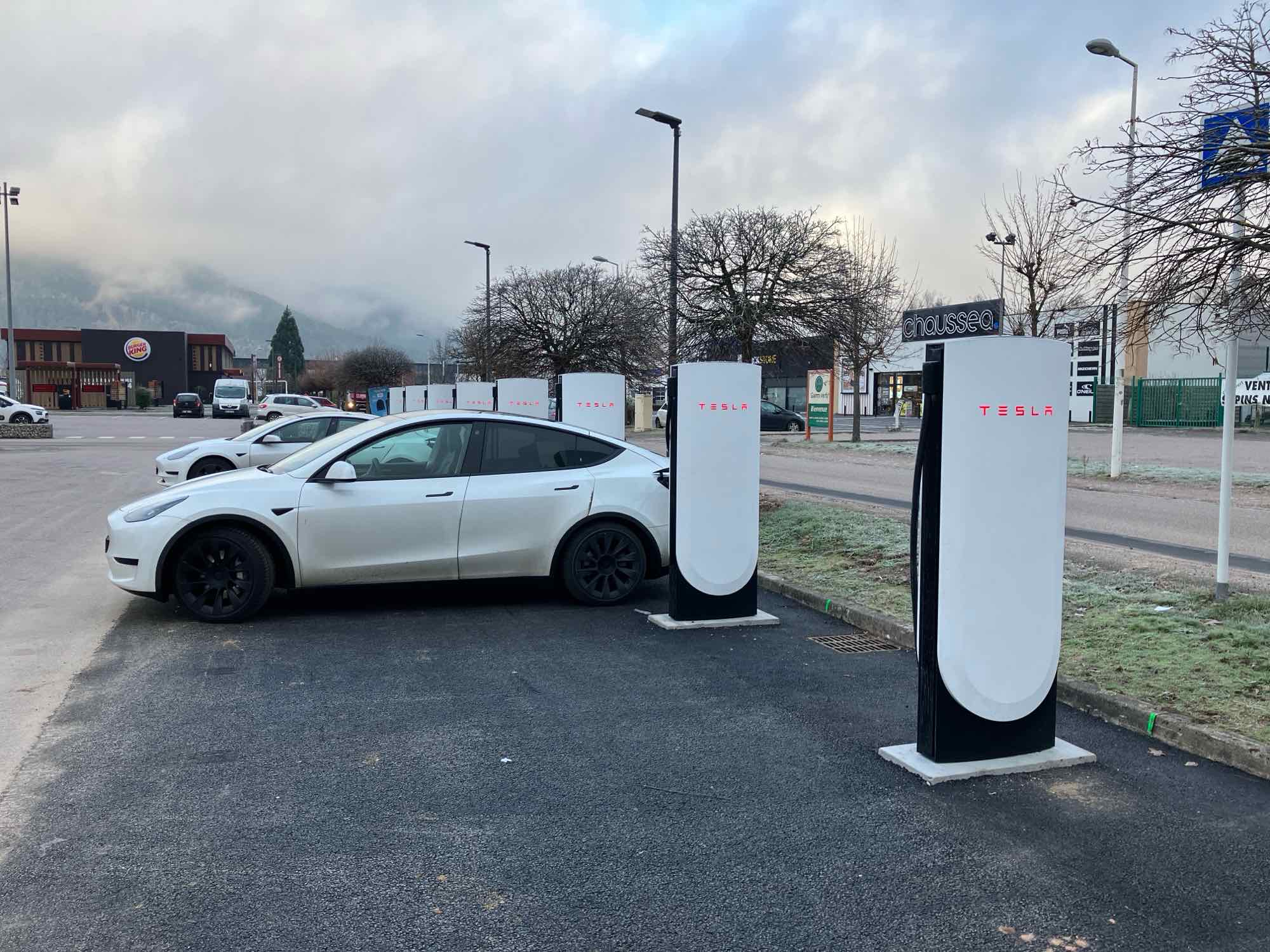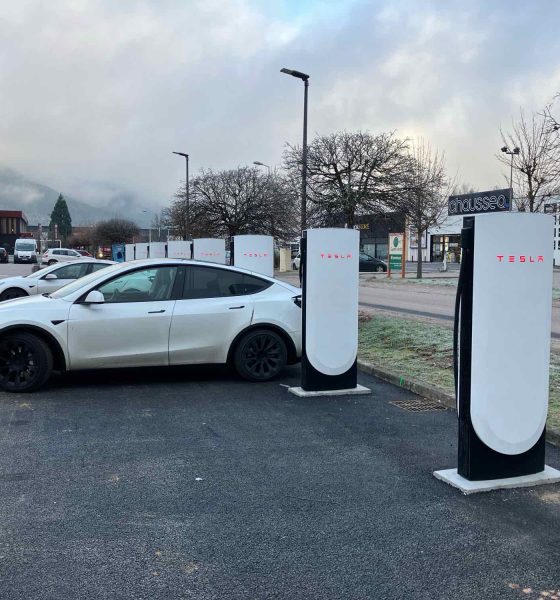Tesla Sweden is seemingly facing its toughest challenge yet in its ongoing conflict with trade union IF Metall. As per recent reports, sympathy strikes from the Swedish Union for Service and Communications Employees (Seko) and the Electricians Union have successfully put a stop to Tesla Sweden’s expansion of its Supercharger Network.
As per a report from Dagens Arbete (DA), Tesla Sweden currently has plans to build about 35 new Supercharger stations in the coming years, from Malmö in the south to Kiruna in the north. This 2024, the electric vehicle maker has been planning to open 20 new Supercharger sites. These plans appear to have been put on hold for now since Seko’s members have stopped connecting Tesla’s Superchargers to local power grids. Seko announced on March 4 that its members will no longer connect Tesla Superchargers to the local power grid, and on March 20, 2024, the Electricians Union expanded its sympathy strike to include new Tesla Supercharger installations.
Janne Halvarsson, group manager at Seko Mellannorrland, stated that he was recently at a new Tesla Supercharger site just north of Sundsvall. As per Halvarsson, the Sundsvall site will probably be the last new Tesla Supercharger for some time, or at least until Tesla Sweden and IF Metall resolve their conflict. “It was connected the week before our blockade started. We had full control of it. I was there myself to see that everything went right,” he said.
IF Metall and its allies have initiated a number of efforts designed to disrupt and stop Tesla Sweden, but the electric vehicle maker has so far been able to bypass the groups’ strikes and blockades. Halvarsson, however, noted that Tesla Sweden will likely find it much harder to deal with the unions’ initiatives against its Supercharger Network. As per Dagens Arbete, the electricity grids are run as local monopolies in Sweden. For example, in Sundsvall, where Tesla’s possible last Supercharger was activated, Sundsvall Elnät AB owns the power infrastructure.
Thus, there is usually only one power grid owner in each geographical area, and only these electricity grid owners are permitted to connect an installation like a Tesla Supercharger to the grid. If the network owner happens to have a collective agreement with Seko, then it would likely deny power to new Tesla Supercharger stations in their respective areas. “I see it as an impossibility to complete this. The signing of collective agreements among the electricity network companies is high. Many of the companies are owned by the municipalities and there are usually collective agreements,” Halvarsson said.
Ann-Charlotte Kling, chairman of Seko Södra, stated that such a scenario has already happened to a Tesla Supercharger in Ljungby in Småland. The Ljungby Tesla Supercharger site features 20 stalls and is ready for activation, but it has not been connected to the grid yet. “The cables are buried, but there is no electricity in them. And there will be no current in them as long as this conflict continues. They simply will not be connected to the electricity grid,” Kling said.
The local electricity company in the area, Ljungby Energi, has confirmed that it is not providing power to the Tesla Supercharger site due to the ongoing conflict between the EV maker and IF Metall. Network manager Jan Olsson described the situation as follows. “The cable is not connected either at their end or in our cables. It will be like this as long as the conflict lasts. Our electricians are connected to Seko,” Olsson noted.
Don’t hesitate to contact us with news tips. Just send a message to simon@teslarati.com to give us a heads up.

News
Tesla FSD fleet is nearing 7 billion total miles, including 2.5 billion city miles
As can be seen on Tesla’s official FSD webpage, vehicles equipped with the system have now navigated over 6.99 billion miles.

Tesla’s Full Self-Driving (Supervised) fleet is closing in on almost 7 billion total miles driven, as per data posted by the company on its official FSD webpage.
These figures hint at the massive scale of data fueling Tesla’s rapid FSD improvements, which have been quite notable as of late.
FSD mileage milestones
As can be seen on Tesla’s official FSD webpage, vehicles equipped with the system have now navigated over 6.99 billion miles. Tesla owner and avid FSD tester Whole Mars Catalog also shared a screenshot indicating that from the nearly 7 billion miles traveled by the FSD fleet, more than 2.5 billion miles were driven inside cities.
City miles are particularly valuable for complex urban scenarios like unprotected turns, pedestrian interactions, and traffic lights. This is also the difference-maker for FSD, as only complex solutions, such as Waymo’s self-driving taxis, operate similarly on inner-city streets. And even then, incidents such as the San Francisco blackouts have proven challenging for sensor-rich vehicles like Waymos.
Tesla’s data edge
Tesla has a number of advantages in the autonomous vehicle sector, one of which is the size of its fleet and the number of vehicles training FSD on real-world roads. Tesla’s nearly 7 billion FSD miles then allow the company to roll out updates that make its vehicles behave like they are being driven by experienced drivers, even if they are operating on their own.
So notable are Tesla’s improvements to FSD that NVIDIA Director of Robotics Jim Fan, after experiencing FSD v14, noted that the system is the first AI that passes what he described as a “Physical Turing Test.”
“Despite knowing exactly how robot learning works, I still find it magical watching the steering wheel turn by itself. First it feels surreal, next it becomes routine. Then, like the smartphone, taking it away actively hurts. This is how humanity gets rewired and glued to god-like technologies,” Fan wrote in a post on X.
News
Tesla starts showing how FSD will change lives in Europe
Local officials tested the system on narrow country roads and were impressed by FSD’s smooth, human-like driving, with some calling the service a game-changer for everyday life in areas that are far from urban centers.

Tesla has launched Europe’s first public shuttle service using Full Self-Driving (Supervised) in the rural Eifelkreis Bitburg-Prüm region of Germany, demonstrating how the technology can restore independence and mobility for people who struggle with limited transport options.
Local officials tested the system on narrow country roads and were impressed by FSD’s smooth, human-like driving, with some calling the service a game-changer for everyday life in areas that are far from urban centers.
Officials see real impact on rural residents
Arzfeld Mayor Johannes Kuhl and District Administrator Andreas Kruppert personally tested the Tesla shuttle service. This allowed them to see just how well FSD navigated winding lanes and rural roads confidently. Kruppert said, “Autonomous driving sounds like science fiction to many, but we simply see here that it works totally well in rural regions too.” Kuhl, for his part, also noted that FSD “feels like a very experienced driver.”
The pilot complements the area’s “Citizen Bus” program, which provides on-demand rides for elderly residents who can no longer drive themselves. Tesla Europe shared a video of a demonstration of the service, highlighting how FSD gives people their freedom back, even in places where public transport is not as prevalent.
What the Ministry for Economic Affairs and Transport says
Rhineland-Palatinate’s Minister Daniela Schmitt supported the project, praising the collaboration that made this “first of its kind in Europe” possible. As per the ministry, the rural rollout for the service shows FSD’s potential beyond major cities, and it delivers tangible benefits like grocery runs, doctor visits, and social connections for isolated residents.
“Reliable and flexible mobility is especially vital in rural areas. With the launch of a shuttle service using self-driving vehicles (FSD supervised) by Tesla in the Eifelkreis Bitburg-Prüm, an innovative pilot project is now getting underway that complements local community bus services. It is the first project of its kind in Europe.
“The result is a real gain for rural mobility: greater accessibility, more flexibility and tangible benefits for everyday life. A strong signal for innovation, cooperation and future-oriented mobility beyond urban centers,” the ministry wrote in a LinkedIn post.
News
Tesla China quietly posts Robotaxi-related job listing
Tesla China is currently seeking a Low Voltage Electrical Engineer to work on circuit board design for the company’s autonomous vehicles.

Tesla has posted a new job listing in Shanghai explicitly tied to its Robotaxi program, fueling speculation that the company is preparing to launch its dedicated autonomous ride-hailing service in China.
As noted in the listing, Tesla China is currently seeking a Low Voltage Electrical Engineer to work on circuit board design for the company’s autonomous vehicles.
Robotaxi-specific role
The listing, which was shared on social media platform X by industry watcher @tslaming, suggested that Tesla China is looking to fill the role urgently. The job listing itself specifically mentions that the person hired for the role will be working on the Low Voltage Hardware team, which would design the circuit boards that would serve as the nervous system of the Robotaxi.
Key tasks for the role, as indicated in the job listing, include collaboration with PCB layout, firmware, mechanical, program management, and validation teams, among other responsibilities. The role is based in Shanghai.
China Robotaxi launch
China represents a massive potential market for robotaxis, with its dense urban centers and supportive policies in select cities. Tesla has limited permission to roll out FSD in the country, though despite this, its vehicles have been hailed as among the best in the market when it comes to autonomous features. So far, at least, it appears that China supports Tesla’s FSD and Robotaxi rollout.
This was hinted at in November, when Tesla brought the Cybercab to the 8th China International Import Expo (CIIE) in Shanghai, marking the first time that the autonomous two-seater was brought to the Asia-Pacific region. The vehicle, despite not having a release date in China, received a significant amount of interest among the event’s attendees.










